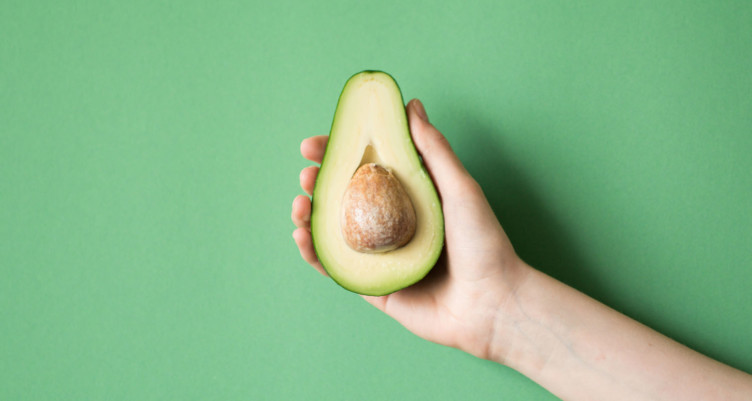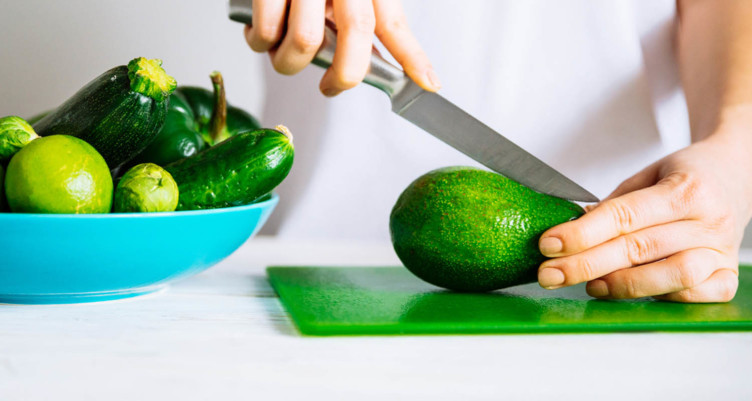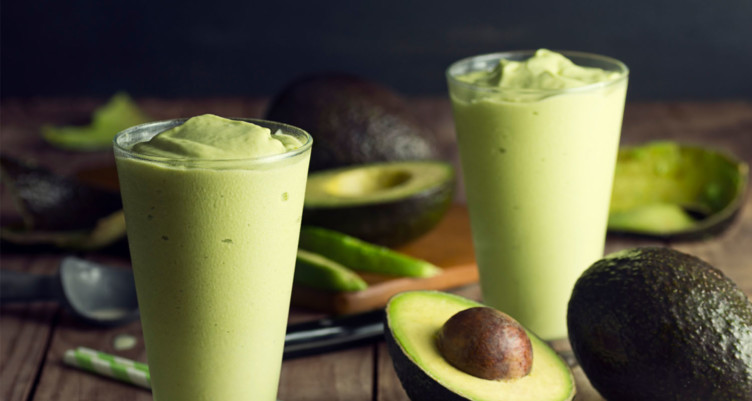How to Store Avocados: Everything You Need to Know (Plus Slicing Tips)

With an abundance of fiber, monounsaturated fats, and vitamins, avocados are the crown jewel of ketogenic diets. When they go on sale, there’s no shame in piling as many as you can into your grocery cart.
However, avocados can be troublemakers. Since their window of ripeness is so small, slicing one open can feel like a game of Russian roulette. Slice too early, and you have a rock-hard fruit. Slice too late, and you risk a mushy brown mess. Not exactly a recipe for a successful Bulletproof-backed guacamole, right?
The Bulletproof Diet frequently recommends fresh produce, but it’s impractical to pick up avocados every day or two. On the other hand, if you pick up your avocados only once a week, you may have to eat through a mountain of ripe ones all at once (a challenge even for die-hard avo lovers).
If you know how to store avocados, you can save the heartache that comes from slicing them too soon or throwing them in the trash. But with so many storage methods, which one keeps their flesh intact and pristine green?
Read on for the definitive guide on how to store avocados—plus tips on sourcing and slicing to maximize the benefits behind this wonder-fruit.
First, choose the perfect avocado

When you spot avocados at the store, don’t fuss over finding a perfectly ripe one unless you plan to eat it right away. If you stock up on perfectly ripe avocados, you risk bruising them under other groceries or in the trunk of your car.
To choose the perfect avocado, leave time on your side: Choose hard, green, under-ripe ones. (With the stem still attached—more on that in a moment.) Then, leave them on your counter undisturbed to ripen for 4-5 days.
For faster ripening, place a few green avocados in a paper bag with an apple or banana, roll up the bag, and let sit for 2-3 days. Apples and bananas release a plant hormone called ethylene that speeds up ripening, while the bag traps the ethylene gas—causing all the fruit in your bag to ripen faster.
How to tell if your avocado is ripe for storing (or eating)
Use your senses —and your avocado stem—to tell whether your fruit is ripe. Your avocado is ripe when the skin is uniformly dark green or almost black in color. If the color is right, give your avocado a very gentle squeeze; it should have some “give” without leaving dents in the skin. If your avocado feels mushy to the touch, it’s over-ripe.
If you’re still not sure if your avocado is ripe, try to remove the stem. If you can’t remove it easily, leave it on—your avocado is not ripe yet. If you can remove the stem, look for a light green color underneath to detect a ripe avocado. If the underside is brown, the avocado is too ripe to store.
Pay close attention to the ripeness window. When you refrigerate avocados, you’ll want to store them at their perfect ripeness level. If you store avocados in the freezer instead, you want to use fruit that is just ripe enough to eat to avoid excess mush when they thaw.
What if my avocado is too ripe or starting to brown?
You might be able to salvage your avocado: While many fruits are completely spoiled the moment they start to brown, you can cut black or discolored parts off of avocados and still eat the remaining green flesh.
However, overripe avocados are not optimal for refrigerating or freezing. Instead, it’s best to use them right away. Whether you use them in an avocado chocolate mousse, avocado dipping sauce, or breakfast wraps, there are plenty of tasty ways to to enjoy those delicious fats without wasting them.
Related: 9 Healthy Avocado Smoothie Recipes
How to cut an avocado: Slicing tips

Starting at the stem, use a paring knife and slice all the way into the avocado, stopping at the pit. Run your knife around the pit in a circular motion to cut the avocado in half. Gently twist the avocado halves to separate the fruit in two.
To remove the avocado pit, rest a folded kitchen towel on your hand and use it to firmly grasp the avocado half with the pit. Using a heavy chef’s knife, knock the blade firmly into the pit. Twist your knife to loosen the pit and remove it from the flesh. With your thumb and forefinger in a downward motion, push the pit off the blade to discard.
Ready to enjoy your avocado right away? Try cutting it into slices or chunks. For slices, use your paring knife and cut even slices lengthwise, all the way down to the skin (without piercing it). Use a large spoon and scoop out your slices.
For avocado chunks, cut lengthwise like you would for slices, then slice perpendicular cuts to create uniform chunks. Scoop out with a spoon.
Note: Slices and chunks do not store well, and there is no truly optimal way to keep them fresh. You might be able to get away with vacuum sealing avocado slices or chunks, but you risk BPA or estrogenic hormones leaching into your food. Other methods leave them too mushy to use. Stick with storing whole, halved, or mashed avocados instead with the methods below.
Related: Avocado-Cucumber MCT Oil Salad Dressing Recipe
How to store avocados

While fresh avocados have the best texture, you can still refrigerate or freeze whole, halved, or mashed avocados to store them. Results, refrigerators, and storing methods may vary, though. While one method might not work for you, try the others to find one that does. No good avocado should go to waste!
How to store avocados: Whole fruit (optimal)
When whole avocados are perfectly ripe, use them immediately or store in the refrigerator for up to five days (and perhaps longer, depending on your refrigerator). The taste and texture should closely resemble a fresh, room-temperature avocado.
You can also store whole avocados in the freezer! This method is optimal since it requires no extra equipment, plastics, or waste. When avocados are just ripe, simply place them in the freezer.
You can freeze avocados without any containers if you plan to use them fairly quickly. However, if you plan to keep them frozen longer, you may want to store your whole avocados in a sealed container so they do not take on any frozen smells or flavors. Frozen avocados stay good up to six months.
When you’re ready to enjoy your avocado, simply thaw on your counter for 1-3 hours, then carefully cut open and use as needed. Don’t thaw them overnight unless you want ultra-mushy results. Ideally, you want to cut into your avocado when it is only partially thawed.
How to store avocados: Halved fruit
If you only use one half of an avocado at a time, use the half with the pit attached for storage. Leaving the pit intact, place your avocado in a sealed container (brushing the flesh with olive oil first, if desired), and refrigerate up to 1 day.
To freeze avocado halves, separate pits and scoop out flesh onto a baking sheet (do not slice). Freeze overnight, then remove from the tray and add to a sealed container. Store in the freezer for up to 3 months. If desired, brush avocados with lemon or lime juice before freezing to prevent browning. Remember to use “just” ripe avocados, since they will be a little mushy after thawing.
How to store avocados: Mashed fruit
To keep mashed avocado green in the refrigerator, add it to a glass container and pack tightly so there are no bubbles in the mixture. Pour 1/2 inch of water over the top of the mash, fit a lid tightly over the top, and refrigerate up to 24 hours. When you’re ready to enjoy your mashed avocado, gently pour out the water and stir the mixture well. This trick works well for keeping guacamole fresh, too.
Want to store avocado mash in the freezer? Mash or puree your avocado with lemon juice (use 1 teaspoon per small avocado, and 2 teaspoons per large avocado). When the lemon juice has been evenly distributed, pour the puree into a silicone ice cube tray and freeze overnight. After cubes set, store in a sealed container in the freezer.
Take a few out when you’re ready to whip up a slice of sweet potato salmon avocado toast—a fantastic source of quality fats that also looks incredibly classy. If you want to make a keto-friendly version of a comfort food classic, you can also use them to create a gluten-free avocado pizza that features a low-carb cauliflower crust.
Related: Should You Eat Avocado Seeds?
How to serve frozen avocados

Warning: Frozen and thawed avocados do not taste the same as fresh ones. The texture is slightly mushier, and they will taste a little sour if you added lemon or lime juice before freezing.
Instead of enjoying all by themselves, frozen avocados are perfect for incorporating into health-supportive recipes. Blend them into smoothies, use them as a base for popsicles and egg-free ice cream, or mix into batter for brownies.
After all, if avocado ice cream earns a stamp of approval from seven-time Super Bowl winner Tom Brady, why not give it a try?
Looking for another way to make use of frozen avocados? Break out your blender so you can craft a tangerine-based smoothie that also includes two scoops of Bulletproof Vanilla Collagen Protein. In about 45 seconds, you’ll have a cool, refreshing concoction that’s perfect for a post-workout snack.
The bottom line: Ultimately, no matter how you slice them, avocados are a great source of quality fats. Whether you prefer them fresh, frozen, in a dressing or in a smoothie, it’s never a bad time to find a way to incorporate this versatile fruit into your diet.
Just make sure to show your avocados plenty of love and attention before you try out a new recipe.
Sign up for early access to sales, product launches, the latest Bulletproof news and more!



